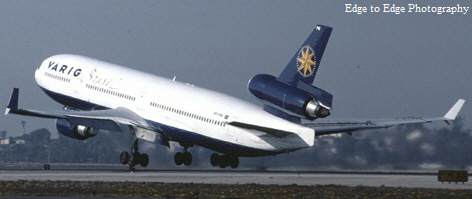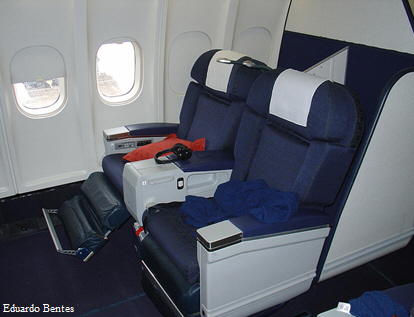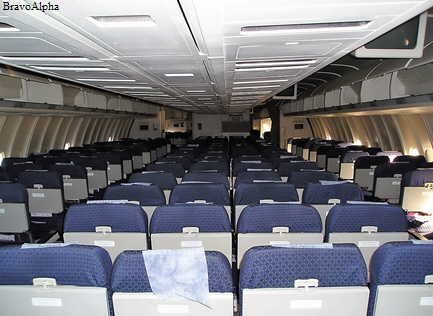|
Aircraft |
||||||||
|
|
VARIG was the first airline in Latin America to operate MD-11 aircraft on November 1991. Its cabin is totally computerized, with digital panels systems. Navigation system is made through a laser gyroscopic. MD-11 has winglets in wing tips, thus reducing the aerodynamic friction and saving about 15% of fuel. The two first MD-11, PP-VOP and PP-VOQ, were officially delivered to VARIG on November 12, 1991 and started flying São Paulo - Rio - Paris - Amsterdam route. Since then MD-11 became VARIG's main aircraft for international long-haul flights. The MD-11 offered a high level of comfort and safety for its passengers. In addition to operating in North America, Europe and Asia, the MD-11 has also operated on some high demand South America and domestic routes.
In December 1992, VARIG received more two units, PP-VPJ and PP-VPK, and other two in December 1993, PP-VPL and PP-VPM, totaling six aircraft received directly from the factory. The MD-11s are the natural substitute for DC-10 and the first two were deactivated in 1992. In 1993, VARIG's MD-11 fleet flew to Paris, Amsterdam, Zurich and Rome.
In 1996 VARIG acquired a MD-11 from the Indonesian airline Garuda (PP-VPN). In 1997 VARIG received more two units previously operated by Garuda (PP-VPO and PP-VPP) and other two in 1998 (PP-VQH and PP-VQI). The PP-VQI was the first MD-11ER (with more range) received by VARIG. In 1998 VARIG's MD-11 fleet flew to Buenos Aires, New York, Paris, Amsterdam, Frankfurt, London, Milan, Rome, Johannesburg, Bangkok and Hong Kong.
In 1999 VARIG received more four units from Garuda (PP-VQF, PP-VQG, PP-VQJ and PP-VQK), totaling 15 MD-11s in the fleet (PP-VQJ and PP-VQK being MD-11ER). In 1999, almost all DC-10s had already been deactivated, and with the end of Boeing 747 operations, MD-11 was reigning alongside Boeing 767 on VARIG's intercontinental routes. In 2000 VARIG's MD-11 began serving Miami, Copenhagen, Los Angeles, Tokyo and Nagoya.
In 2000 VARIG received two MD-11 previously operated by Vasp, PP-VQL and PP-VQM, which replaced the first two PP-VOP and PP-VOQ. In 2001 VARIG received another MD-11 from Vasp, PP-VQX. However, in 2002, PP-VPL and PP-VPM were returned.
With financial difficulty, VARIG started looking for cheaper used MD-11s. But this has led the company to acquire aircraft with other type of engines. All VARIG's MD-11s were equipped with General Electric GE CF6-80C2 D1F turbines. However the company began to acquire aircraft previously operated by Swissair equipped with Pratt & Whitney PW 4460 engines. In 2003 VARIG acquired three former MD-11 Swissair (PP-VTF, PP-VTG and PP-VTH) and five in 2004 (PP-VTI, PP-VTJ, PP-VTK, PP-VTP, PP-VTU). Also in 2004 VARIG returned PP-VTG. Even though VARIG acquire more units from Swissair, it kept an active fleet of 15 aircraft. In 2005 a total of eight units were returned, PP-VPJ, PP-VPK, PP-VQL, PP-VQM, PP-VTF, PP-VPN, PP-VPP and PP-VQI.
In 2005, VARIG LOG, a cargo subsidiary, became the first airline in
Latin America to operate all cargo version MD-11F (PP-LGD and PP-LGE).
The two units operated by VARIG LOG came from Korean Air. PP-LGE
stopped operating in 2008 and was returned in 2010, and PP-LGD was
returned in 2009.
VARIG had selected Boeing 777-200 as a replacement for MD-11 and
received the first two units in 2001. The company's intention was to
gradually replace its MD-11 fleet with Boeing 777. However, the
company's financial crisis prevented this replacement and the MD-11
was part of VARIG's fleet until the end of its operations in 2006.
Destination of the VARIG MD-11:
- Converted to freighter for Gemini Cargo: PP-VOP and PP-VOQ.
- Converted to freighter for UPS: PP-VPJ, PP-VPK, PP-VPL, PP-VPM,
PP-VTI, PP-VTJ, PP-VTK, PP-VTP, PP-VTU
- Converted to freighter for FedEx: PP-VPN, PP-VPO, PP-VPP, PP-VTG
- Converted to freighter for Aeroflot: PP-VQF, PP-VQG, PP-VQH
- Converted to freighter for Finnair: PP-VQI
- To Tam: PP-VQJ, PP-VQK, PP-VQX
- Converted to freighter for Lufthansa: PP-VQL, PP-VQM
- Returned and stocked: PP-VTF, PP-VTH
VARIG's MD-11 internal configuration:
293 seats
First Class: 16 seats
Business Class: 56 seats
Economy Class: 221 seats
271 seats
First Class: 18 seats
Business Class: 35 seats
Economy Class: 218 seats
285 seats
First Class: 6 seats (2+2+2 seats per row)
Business Class: 49 seats (2+3+2 seats per row)
Economy Class: 230 seats (2+4+3 seats per row)

289 seats
First Class: 6 seats (2+2+2 seats per row)
Business Class: 49 seats (2+3+2 seats per row)
Economy Class: 234 seats (2+4+3 seats per row)

282 seats
First Class: 12 seats (2+2+2 seats per row)
Business Class: 49 seats (2+3+2 seats per row)
Economy Class: 221 seats (2+4+3 seats per row)

285 seats
First Class: 12 seats (2+2+2 seats per row)
Business Class: 49 seats (2+3+2 seats per row)
Economy Class: 223 seats (2+4+3 seats per row)

282 seats
First Class: 4 seats (2+2+2 seats per row)
Business Class: 49 seats (2+3+2 seats per row)
Economy Class: 229 seats (2+4+3 seats per row)

264 seats
First Class: 4 seats (1+2+1 seats per row)
Business Class: 49 seats (2+3+2 seats per row)
Economy Class: 211 seats (2+4+3 seats per row)}

284 seats
First Class: 4 seats (1+2+1 seats per row)
Business Class: 49 seats (2+3+2 seats per row)
Economy Class: 231 seats (2+4+3 seats per row)

241 seats
First Class: 12 seats (1+2+1 seats per row)
Business Class: 49 seats (2+3+2 seats per row)
Economy Class: 180 seats (2+4+3 seats per row)

287 seats
First Class: 6 seats (1+2+1 seats per row)
Business Class: 49 seats (2+3+2 seats per row)
Economy Class: 232 seats (2+4+3 seats per row)

|














